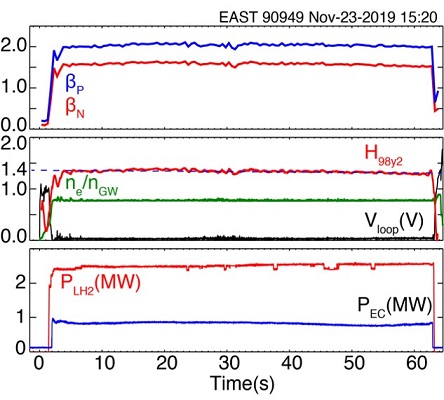Speaker
Description
Recent EAST experiment has successfully demonstrated long pulse steady-state high plasma performance scenario with core-edge integration since the last IAEA in 2018 $[1]$. A discharge with a duration over 60s with $\beta_P$ ~2.0, $\beta_N$ ~1.6, $H_{98y2}$~1.3 and internal transport barrier on electron temperature channel is obtained with multi-RF power heating and current drive, i.e. ~2.5 MW LHW and 0.9 MW ECH, where the plasma configuration is the upper single null with the strike points on the tungsten divertor (shown in figure 1). Loop voltage was well controlled to be zero which indicates the fully non-inductive current drive condition. Small ELMs (frequency ~100-200Hz) were obtained in this long pulse H-mode discharge. In the operation, the optimization of X-point, the outer gap and local gas puffing near LHW antenna were investigated to maintain RF power coupling and to avoid formation of hot spot on the 4.6 GHz LHW antenna. Global parameters of toroidal field $B_T$ and line averaged electron density <$n_e$> were optimized for high current drive efficiency of LHW and for on-axis deposition of ECH. The on-axis ECH was applied not only for the core electron heating, but also for the control of high $Z_{eff}$ impurities in the core plasmas.

Meanwhile, a higher $\beta_N$ ~1.8 with a duration of 20s is achieved by using the modulated neutral beam. Several normalized parameters of $\beta_P$ ($\beta_P$ ~2.0), $\beta_N$ ($\beta_N$ ~1.8), $H_{98y2}$ (~1.3), $n_e/n_{GW}$ (~ 0.75) are close or even higher than the phase III 1GW scenario of CFETR steady-state $[2]$. Other features such as metal wall (tungsten divertor), low torque injection ($\Gamma_{inj}$~1.0Nm), electron dominated heating ($T_e$>$T_i$), moderate bootstrap current fraction ($f_{bs}$~50%), broaden current density profile with the central q(0)>1.0 and good energy confinement, have also been demonstrated in this scenario. Note that high-Z impurity accumulation in the plasma core was well controlled in a low level by using the on-axis ECH and reducing the fast ion losses through beam energy optimization.

More recently, EAST has demonstrated a compatible core and edge integration in high $\beta_P$ scenarios: high confinement $H_{98y2}$>1.2 with high $\beta_P$ ~2.5/$\beta_N$~2.0, $f_{bs}$~50% is sustained with reduced heat flux by active divertor heat flux at high density $n_e/n_{GW}$ ~0.7 and moderate $q_{95}$~6.7 (shown in figure 2). The energy confinement quality was almost maintained with $H_{98y2}$>1.2 during the radiation feedback control. By active impurity seeding through radiative divertor feedback control via radiated power, the peak heat flux is reduced by ~30% on the ITER-like tungsten divertor, here a mixture of 50% neon and 50% $D_2$ is applied. Note that EAST has developed a number of heat flux control techniques to reduce heat load in separate experiments.
In summary, recent EAST experiments demonstrated long pulse steady-state high plasma performance scenarios and heat flux feedback control. Detailed physics basis to investigate stability and particle transport will be presented for the understanding of fully integrated core-edge solutions on EAST. As a test bed for ITER and CFETR, the EAST upcoming experiments will further exploit additional heating power and demonstrate the core-edge integration of steady-state long pulse high performance scenarios with full metal walls.
This work was supported in part by National Natural Science Foundation of China under Grant No. 11975274,11975276, US Department of Energy under DE-SC0010685 and DE-FC02-04ER54698.
$[1]$ X. Gong et al 2019 Nucl. Fusion 59 086030
$[2]$ J. Huang et al 2020 Plasma Phys. Control. Fusion 62 014019
| Affiliation | Institute of Plasma Physics, Chinese Academy of Sciences |
|---|---|
| Country or International Organization | China |
